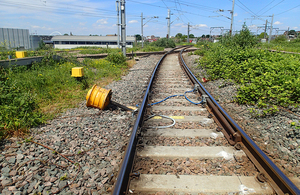RAIB report 07/2020: Freight train derailment at Willesden High Level Junction
RAIB has today released its report into a freight train derailment at Willesden High Level Junction, north-west London, 6 May 2019.

Rails with sleepers showing derailment marks on the approach to Willesden High Level Junction (after track restoration)
Summary
At around 21:30 hrs on 6 May 2019 a single wagon in a freight train derailed on a curve approaching Willesden High Level Junction in north-west London. The wagon re-railed as it passed over the junction. Although no-one was injured, a derailment like this has the potential to foul lines that are open to passenger traffic or strike structures.
The track was supported by an earth embankment that Network Rail had been monitoring since October 2016, and which was showing signs of progressive seasonal movement. The empty two-axle wagon derailed where the track cross-level had been changing. Derailment occurred because the wagon encountered a significant track twist and had an uneven wheel load distribution. This combination resulted in there being insufficient load at the leading left-hand wheel to prevent the wheel flange climbing over the railhead. A check rail would have prevented the derailment. Network Rail had completed a risk assessment that had concluded this safeguard was not necessary on the small-radius curve.
The track twist had developed rapidly. This was because of the poor condition of the earth embankment and the loss of ballast support from under the sleepers. The measures that Network Rail had in place for inspection, maintenance and mitigation were not effective in detecting this risk and protecting the safe running of trains.
The wagon had a diagonal wheel load imbalance. This arose because the suspension adjustment arrangement was susceptible to introducing an imbalance of this type and routine maintenance had not detected that it was present.
Within Network Rail, separate teams are responsible for track maintenance and earthwork management. RAIB has identified the lack of sharing of information between these teams as a possible underlying factor.
Recommendations
RAIB has made four recommendations:
- Three are directed to Network Rail and concern:
- the use, and limitations, of information from its track geometry measurement trains for understanding the condition of the track and problems with the track bed and/or supporting earthwork structures, and how this may affect the safe running of trains
- measures to mitigate the risks arising from known defects in supporting earthwork structures.
- One is directed at DB Cargo, the owner and maintainer of the derailed wagon, relating to the maintenance of this and similar two-axle wagons.
RAIB has additionally identified learning points concerned with indications of poor track bed condition, the importance of good liaison between track maintenance and earthwork management teams and the management of wagon diagonal wheel load imbalance.
Notes to editors
- The sole purpose of RAIB investigations is to prevent future accidents and incidents and improve railway safety. RAIB does not establish blame, liability or carry out prosecutions.
- RAIB operates, as far as possible, in an open and transparent manner. While our investigations are completely independent of the railway industry, we do maintain close liaison with railway companies and if we discover matters that may affect the safety of the railway, we make sure that information about them is circulated to the right people as soon as possible, and certainly long before publication of our final report.
- For media enquiries, please call 01932 440015.